DIY gas convector: installation steps for factory-made appliances + homemade assembly
Gas convectors are quite justified in popularity. They work on a commonly available type of fuel, which attracts with a low price, minimal volume of combustion products and high efficiency. Without any problems, you can install and even mount a gas convector with your own hands, if you know the specifics of these works.
We will tell you how to install a gas heating device that provides convective heating. We will introduce you to the principle of its action and design features.
In the article we propose, you will find guidance on the installation and manufacture of proven homemade products. Our advice will no doubt be appreciated by independent craftsmen.
The content of the article:
Secrets of the popularity of a gas convector
Convectors, which use gas, equip residential, industrial and commercial facilities. They are especially in demand in private homes, small workshops, cafes, not connected to centralized heating systems.
Often, gas convectors are used in heating large vehicles: campers, trucks, buses. They are more convenient to operate than solid fuel stoves and diesel fuel heaters, more economical than electrical appliances.
Job convection type appliances based on the natural movement of heated air passing through the combustion chamber located inside the heat exchanger. The heat exchanger heats the gas burner, to which gas is supplied through the nozzle through a hose or pipe.
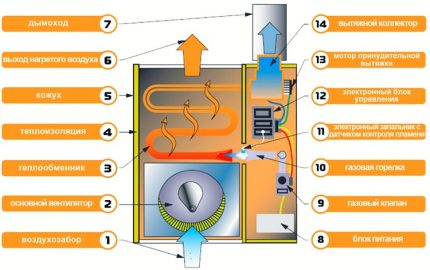
Almost all models of gas convectors can work both on main gas and on a liquefied combustible mixture of propane and butane. You can connect them to the gas supply network, and to the cylinder or gas tank. It all depends on the technical conditions of the facility being built.
Gas-fired convectors come with open and closed combustion chambers. The former are cheaper both in price and in the following operating costs. The second is more expensive, but much safer, and therefore they are more likely to buy them. We will analyze the principle of operation of just such a device.
The air required for combustion enters the combustion chamber of the gas device through coaxial chimney. If it is simplified to imagine a coaxial design, then these are two pipes of different sections, one of which is installed inside the other. Due to the features of the device, the coaxial system performs two important actions.
Through the gap between the pipes, air is drawn into the combustion chamber, which is required to stimulate and maintain the combustion process. A few, but extremely toxic products of the processing of blue fuel are discharged through the central pipe, i.e. outside the heated object.
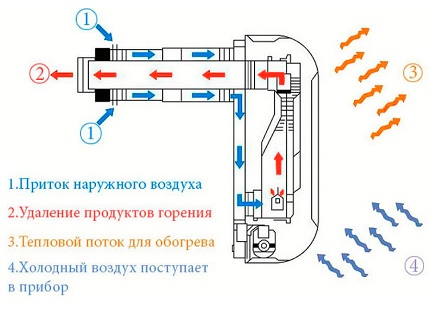
Convection gas heater is absolutely not connected with the airspace in the room. A fresh portion of the air is taken from the street, flue gases, soot and fumes accompanying the burning of gas are sent there. During operation, the gas convector does not burn out oxygen in the treated object and does not threaten users with carbon monoxide poisoning at all.
The movement of air through gas convectors is natural and forced. In the first case, a cold stream spontaneously displaces warm into the room from the heat exchanger. In the second - the movement and change of the cooled and heated air mass is accelerated by the fan, which needs power supply.
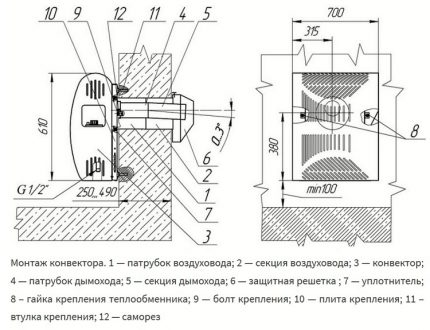
The supply of blue fuel to the burner is made through the gas valve. It doses the supply and performs the function of a kind of climate system that maintains the temperature required by the owners in the room. Volatile devices are also equipped with automation.
Automatic protection systems guarantee safe operation. They interrupt the supply of gas to the chamber in the event of pressure fluctuations in the gas network or flame attenuation in the burner. Deflectors are installed on the coaxial pipes of gas convectors, which exclude blowing out of nozzles by gusty winds.
The author of the video will familiarize with the principles of operation and features of the gas convector heater device:
Craftsmen develop and assemble unique models gas heaters, considering the principle of their work and device features. In their homemade products, the basic rule is taken into account - you just need to ensure safe and efficient heating of the air passing through the device with a gas burner.
We will definitely consider the tested models of home-made gas convective heaters, but first we will deal with the rules for installing and connecting ready-to-use equipment offered by the trade.
Norms of arrangement of gas convectors
The installation of gas convectors is carried out inside heated residential, utility and industrial premises. They are allowed to be used in warehouses, garages and other explosive facilities subject to the rules of use.
The number of devices is calculated based on the cubic capacity of the room to be processed. It is believed that on average 1 kW generated by the device is able to provide heat of 20 m³. Of course, for the accurate selection of slightly averaged values, besides, the climatic conditions and real heat loss of the building affect the calculations, but you can get an idea of the approximate number of convectors required.
Mounting that homemade, factory gas convector is made on the main wall. It is recommended to place it directly under the window, but not in a niche that impedes the movement of air flow. Install the device so that operation and maintenance do not interfere.
Most manufacturers of gas convection devices recommend maintaining the following distances from building structures:
- From a floor plane with a combustible coating of at least 150 mm.
- From the plane of the floor with a coating not prone to burning, 100 mm.
- From a window sill or other similar structure towering above a convector, at least 100 mm.
- From left / right / rear structures and objects of 150 mm.
- From the front wall of the gas convector to the nearest obstacle from 500 mm.
It is imperative that the gas convector be equipped with a coaxial chimney that is led out through the main wall or through the roofing system. The thickness of the wall crossed by the chimney can be 600 ... 800 mm.
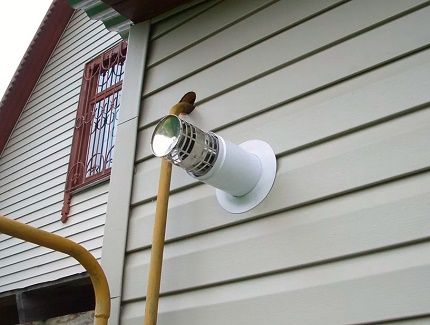
When exiting through the wall between the coaxial pipe and the surface of the earth can not be less than 300 mm. If it comes out at a height of more than 2000 mm from the surface of the earth, protection against atmospheric negativity and unauthorized entry should be provided.
Wall mounting and fixing steps
To output the coaxial pipe through the wall, you need to drill a hole in it, the radius of which will allow you to bring the chimney out, insulate and seal the gap between the pipe and the wall. According to the position of the drilled hole, the fixing points of the convector on the wall are marked.
Consider the process of preparing the hole for the output of the coaxial pipe in the wall of the frame structure:
Naturally, first of all, you need to fix the brackets on which the device will be hung. Upon completion of their fixation, they begin to install the unit and connect it to the chimney and gas pipe. But first you need to prepare it for installation.
In cottages and in change houses, the walls of which do not have a bearing capacity sufficient to load a device with a cast-iron heat exchanger, it is better to put the heater on supports, for example, as in the following gallery:
The casing is removed from the convector, and an o-ring is put on the hole located on the back side. Then the device is tipped over to the wall, as a result of which the coaxial pipe is inserted into the hole provided with a sealant at the back of the unit. Then the connection must be strengthened with a mounting sleeve.
Now you need to connect to the gas supply pipe or hose. If it is connected to the main gas, it is desirable that the pipe is already connected to the installation site of the convector. Before entering the gas channel into the device, there must be a tap so that it can shut off the supply if it is planned to repair, replace or clean.
Note that a centralized gas system can be connected to the pipe only by representatives of the organization with which contract signed for the supply of gaseous fuel and maintenance of gas equipment. The master must have certification from the manufacturer with the right to carry out installation work.
The duties of the gas operator, called to install the gas convector, include connecting to the gas supply system and checking the connection of the unit for leaks. After completion, the employee must issue an act to the owners, which lists all the actions committed by him.
You can connect a convector to a gas cylinder with your own hose. But it should be remembered that the connection must be made using a gearbox and a gas valve. You also need to know that the nozzles for supplying the main gas and the liquefied gas mixture differ in diameter.
It is desirable to equip the opening under the coaxial pipe with the use of a flange that ensures the tightness of the external assembly. But before installation, the usual option needs to be slightly modified, depending on the method of attachment. Consider the example of preparing and installing an external seal on a wooden wall:
After finalizing the flange mounted on the coaxial pipe from the side of the street, proceed with its installation:
If the device was sold with nozzles designed for main gas, before installation, they should be changed to those whose size and model are specified by the equipment manufacturer. It is necessary to replace all nozzles available in the device.
Do not forget that gas bottle any capacity can not be placed above the basement, located in the basement and basement levels of the house. It is forbidden to install it directly next to the heater. A distance of at least one meter must be maintained between the device and the cylinder. Better more so that heating the cylinder with a heater was completely excluded.
Rules for competent operation
Only adult users who have carefully studied the manual and operating recommendations can turn on and off the gas convector, regulate its operation modes. It is unacceptable that the younger generation or incompetent people participate in these processes. If it is impossible to protect the gas convector from their intervention, then it is better to refuse to install the device ahead of time.
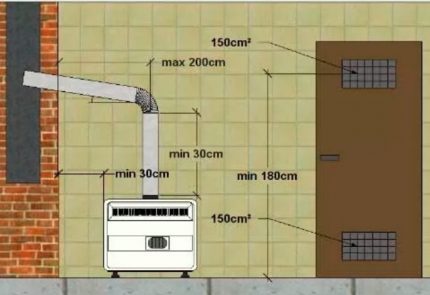
Remember that if a specific gas smell is detected in the room, the faucet at the inlet to the convector should be immediately shut off. In no case should one “sparkle” in such a situation: strike matches, turn on lights, use a lighter, etc. If you do not comply with these requirements, a small leak at first glance can cause a devastating explosion.
The room in which the leak was detected should be ventilated immediately by opening the windows and door wide. You should immediately call the employees of the gas organization that connected your device to the centralized highway, or emergency service. The gas heater can only be operated after the leak has been completely eliminated or the appliance has been repaired.
Homemade gas convectors
Among the developments of improvised convectors that process gas into thermal energy, there are not too many different solutions. This is due to the danger of errors in the construction of devices operating on blue fuel. The slightest miscalculation can lead to an explosion, poisoning, fire.
However, there are some interesting designs worth considering. They can come in handy in heating cottages, country houses, trailers, camping tents, garages.
Option 1. IR burner heater
In fact, this is just a refinement of the usual infrared gas burner Solyarogaz brands. The device runs on bottled gas. The inventor and performer of the idea used the GII-2,3 model, the working panel of which can be installed horizontally.
On this working panel, which normally heats the space with flameless processing of gaseous fuel, they simply welded and installed the original heat exchanger. It is a metal cube, with metal tubes laid inside the case.
The heat exchanger has no bottom; it would prevent the passage of heat waves. A pipe for connecting the chimney is displayed at the top. A pair of fans from the computer is installed behind to accelerate the flow of air currents.
Structurally, this model resembles a heater for air heating systems. By the principle of action - too. The air drawn into the tubes of the device is heated by a gas burner, then it is forced out of the tubes by a fresh portion of cold air.
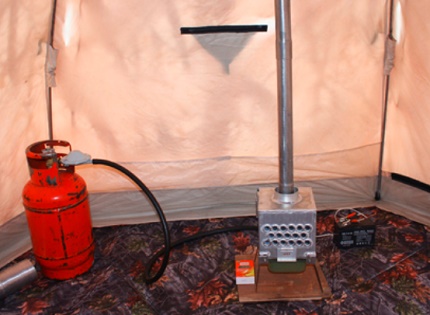
According to the owner of the invention, a modified burner heats a tent much faster than it does, but without a heat exchanger. All gaseous fuel processing products are discharged through a pipe connected to the pipe. Oxygen does not burn, gas spends economically. For fishermen, hunters and tourists this is a real find.
Option # 2. Using a decommissioned heater
This option is generally extremely simple, it was invented to save on heating the garage. All refinement was to repair the decommissioned convector and to remove the casing. The result allowed to significantly increase heat transfer and heating rate, but he has problems with safety.
Firstly, the tightness is broken. In case of accidental attenuation, the gas valve of the heater will, of course, stop the flow.
However, with constant burning, oxygen from the air mass in a confined space will be burned out, therefore, it will be necessary to regularly ventilate the garage in one gulp or construct forced-air ventilation.
Secondly, an open heat exchanger can easily cause a burn. But where children do not run, this can not be considered a minus. An adult is unlikely to forget that the case has been removed from the heater and that if you move it improperly, you can burn yourself near the appliance.
With a similar solution, but used to heat the trailer, the following video will introduce you:
A 30 m² garage without a casing will heat up in about five minutes. Gas consumes in the amount of not more than 500 rubles in the winter month. It works less frequently in autumn and spring, which means that expenses are still decreasing.
Option # 3. Duct fan upgrade
The essence of the alteration is to install an air duct with an exhaust fan on the front grill. The heat generated by the convector is directed to the owner’s working area. There are no special tricks, but there is a significant reduction in heating costs.
Features of the device and the operation of the modernized gas convector are presented in the video:
The combustion products are discharged outside the facility as usual - through a coaxial pipe, through it fresh air is supplied to the burner to maintain the flame. This homemade product is significantly safer than the previous model, but you will need to ventilate the treated room periodically anyway. After all, without a doubt, she will "drive" dust clouds.
findings
Undoubtedly, gas convectors are the most popular type of heating appliances for small residential, domestic facilities and even vehicles. The difficulty is that the most affordable and possible type of fuel can be dangerous if you violate operational regulations.
If the rules of use are clearly observed, there will be no threats to life, health or property. Homemade products will not create any risks if the gas moves along hermetic circuits. However, if there is any doubt that you can ensure tightness, it is better to buy a factory-made device and not tempt fate.
Want to talk about how to install and connect your own gas convector? Perhaps you have an interesting idea in your arsenal for assembling or upgrading a gas heater? Please leave comments in the block form below, ask questions and post a photo on the topic of the article.

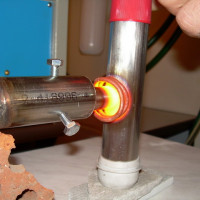 DIY gas heater: instructions to help home craftsmen
DIY gas heater: instructions to help home craftsmen  What is better to buy - a convector or fan heater? Comparative review
What is better to buy - a convector or fan heater? Comparative review 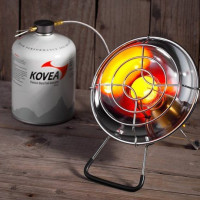 Homemade heater for the garage: how to make a device yourself
Homemade heater for the garage: how to make a device yourself 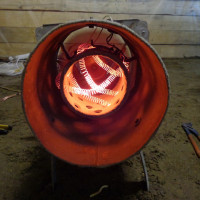 Do-it-yourself electric heat gun: the pros and cons of homemade + assembly instructions
Do-it-yourself electric heat gun: the pros and cons of homemade + assembly instructions 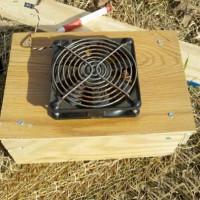 How to make a fan heater with your own hands: a briefing on the manufacture of a homemade device
How to make a fan heater with your own hands: a briefing on the manufacture of a homemade device 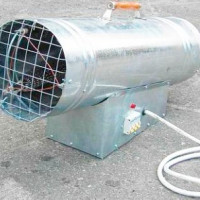 Do-it-yourself heat gas gun: step-by-step assembly instructions
Do-it-yourself heat gas gun: step-by-step assembly instructions  How much does it cost to connect gas to a private house: the price of organizing gas supply
How much does it cost to connect gas to a private house: the price of organizing gas supply  The best washing machines with dryer: model rating and customer tips
The best washing machines with dryer: model rating and customer tips  What is the color temperature of light and the nuances of choosing the temperature of the lamps to suit your needs
What is the color temperature of light and the nuances of choosing the temperature of the lamps to suit your needs  Replacement of a geyser in an apartment: replacement paperwork + basic norms and requirements
Replacement of a geyser in an apartment: replacement paperwork + basic norms and requirements